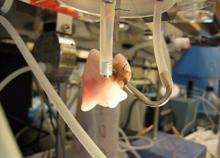July 15, 2010 report
Bioartificial lungs transplanted into rats (w/ Video)

(PhysOrg.com) -- Researchers in the US have grown lungs in their laboratory and transplanted them into rats. The transplanted lungs functioned for up to six hours. The current work follows independent research announced last month by Yale University, in which the first ever bioengineered lung tissue was transplanted into rats. In those experiments the tissue carried out gas exchange for only two hours.
The scientists involved in the latest experiments were from the Massachusetts General Hospital and Harvard Medical School in Boston, and were led by Harald C. Ott. They removed the left lungs from the rats and then stripped the lungs of cells using a mild detergent in a process called decellurization. The blood vessels, airways and connective tissues remained as a kind of structural scaffolding or matrix. They then added epithelial and endothelial cells and nutrients and incubated the mix in a bioreactor to help the lung cells grow and remain supple and flexible.
In less than a week the cultivated lungs resembled the original lungs in size, and once gas exchange had been demonstrated in culture, they were transplanted into the rats. Anatomical measurements and study of oxygen flow demonstrated the new lungs were working. They continued to work for up to six hours, after which they failed through accumulation of fluid inside the lung and resultant capillary leakage.
The experiments did not successfully regenerate all the types of cells found in the lungs, and Ott said there remained a lot of work to do before the technique could be scaled up to produce human lungs. He estimated we might be seeing regenerated organs for use in human patients within five or 10 years.
At present the best option for patients with serious lung damage caused by conditions such as cystic fibrosis or chronic obstructive pulmonary disease is a lung transplant, but there is a severe shortage of donor lungs, and the risk of rejection is high even if a donor is found. As with the transplantation of most organs, many patients die before a donor organ can be found.
Scientists are looking for alternatives to reduce the need for transplants. Other advances include the lung-on-a-chip, and the bioartificial rat heart created two years ago by Ott, then working at the University of Minnesota. Ott created the heart by removing all the cells of a dead heart and then “seeding” it with live cardiac cells to re-grow the organ.
The results of Ott’s latest research were published in the journal Nature Medicine.
More information: Regeneration and orthotopic transplantation of a bioartificial lung, Harald C Ott, et al., Nature Medicine (2010), DOI:10.1038/nm.2193
© 2010 PhysOrg.com
















